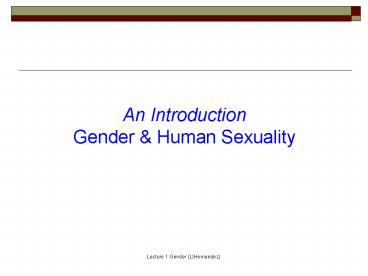Gender PowerPoint Slides - PowerPoint PPT Presentation
Title:
Gender PowerPoint Slides
Description:
An Introduction Gender & Human Sexuality Lecture Overview Sex and Gender The Study of Human Sexuality Sexual Behavior Sexual Problems Sexually Transmitted Infections ... – PowerPoint PPT presentation
Number of Views:203
Avg rating:3.0/5.0
Title: Gender PowerPoint Slides
1
An Introduction Gender Human Sexuality
2
Lecture Overview
- Sex and Gender
- The Study of Human Sexuality
- Sexual Behavior
- Sexual Problems
- Sexually Transmitted Infections
3
Sex and Gender
- Sex refers to the biological aspects of being
male or female (and the physical acts of
intercourse/masturbation) - Sex differences are physical differences
- Gender refers to the psychological and
sociocultural meanings added to biological sex - Gender differences result from peoples thinking
about gender
4
Dimensions of Sex
Sex Dimensions Male Female
1. Chromosomes 2. Gonads 3. Hormones 4.
External genitalia 5. Internal accessory
organs 6. Secondary sex
characteristics 7. Sexual orientation
XY XX Testes Ovaries Androgens Estrogens Peni
s, scrotum Labia, clitoris, vaginal
opening Prostate, seminal Vagina,
uterus, vesicles, fallopian tubes, vas
deferens cervix Beard, low voice,
Breasts, sperm emission
menstruation Heterosexual, gay, Heterosexual, bise
xual lesbian, bisexual
5
Human Reproductive Structures
6
Gender Dimensions
7
Determinants of Gender Identity
- Gender identity refers to the personal view of
oneself as male or as female - Environmental factors were assumed to be central
determinants of gender identity - Notion was that social-cultural influences shaped
gender identity - The case of the castrated identical twin whose
gender identity was reassigned following a
botched circumcision was taken as important
evidence for the role of environmental factors - Problem he later rejected the reassignment and
took on a male gender identity (now this case
supports a biological view of gender identity)
8
Gender Role Development
- Gender roles are societal expectations for normal
and appropriate female and male behavior - Social-learning theory argues that gender roles
develop as children - receive rewards/punishments for gender role
behaviors - watch and imitate the behaviors of others
- Cognitive-developmental theory argues that
children develop gender schemas
9
Gender Differences
- Cognitive abilities
- Females score higher on verbal skills
- Males score higher on math, visual-spatial skills
- Aggression
- Males exhibit greater physical aggressiveness
- Females are higher on relational aggression
- E.g. spreading rumors about others, ignoring or
excluding others
10
Androgyny
- Androgyny combining characteristics considered
typically male with characteristics considered
typically female - Masculine and androgynous individuals generally
have higher self-esteem and creativity, are more
socially competent and motivated to achieve, and
exhibit better overall mental health.
11
Scientific Study of Sexuality
- Havelock Ellis was among the first physicians to
initiate a scientific study of sexuality - His studies revealed that nocturnal emissions
were not dangerous - Ellis later came to promote the dissemination of
accurate information on human sexuality - Alfred Kinsey used surveys and interviews to
study sexual practices and beliefs - Masters and Johnson brought the study of
sexuality into the laboratory to study the sexual
response cycle
12
Sexual Response Cycle
13
Sexual Activity
- Men are thought to have greater sexual drive,
interest and activity than do women. Why? - Evolutionary Perspective Men developed an
interest in sex with multiple partners in order
to maximize the likelihood of passing on their
genes women seek a good provider - Social Role Approach Gender differences reflect
cultural roles and division of labor - Women prefer resource-rich men, but only when
they lived in cultures with little reproductive
freedom/educational equality
14
Sexual Orientation
- Homosexuality may reflect the impact of
biological factors on sexual orientation - Biological factors are supported by twin studies
that suggest genetic influence on sexual
orientation - Homosexuality does not reflect
- Poor parenting smothering mother, detached
father - Arrested development or an immature personality
- Childhood seduction by adults
- Modeling of gay behaviors and views from others
15
Sexual Function
- Sexual behavior in males and females involves
arousal of the peripheral sex organs, the spinal
cord, and the brain. - Factors that modulate activity within any of
these regions can impair sexual function - Sexual arousal involves activity within the
parasympathetic nervous system (allows for blood
flow to the sex organs) - Sexual orgasm involves the activation of the
sympathetic nervous system
16
Sexual Dysfunctions
- Male sexual problems
- Impotence (inability to maintain an erection)
- Premature ejaculation
- Male and Female
- Dyspareunia (painful intercourse)
- Inhibited desire
- Sexual aversion
- Female
- Orgasmic dysfunction
- Vaginismus (painful contraction of the vaginal
muscles)
17
Sex Therapy Masters and Johnson
- Therapy focuses on the relationship
- Therapy integrates physiological and psychosocial
factors - Therapy focuses on cognitive factors
- Therapy focuses on specific behavioral techniques
18
Drug Actions on Sexuality
- Alcohol Reduced testes size and suppressed
hormone function - Cocaine Erectile disorder, inhibited orgasm,
lowered sperm counts - Barbiturates Reduced desire, erectile disorder,
delayed orgasm - Marijuana Reduced testosterone levels, reduced
desire - Tobacco Decreases the frequency and duration of
erections and of vaginal lubrication
19
Sexually Transmitted Diseases
20
AIDS
- Although AIDS is transmitted only through sexual
contact or exposure to infected bodily fluids,
many people have irrational fears of contagion. - One million North Americans are HIV positive and
therefore carriers































